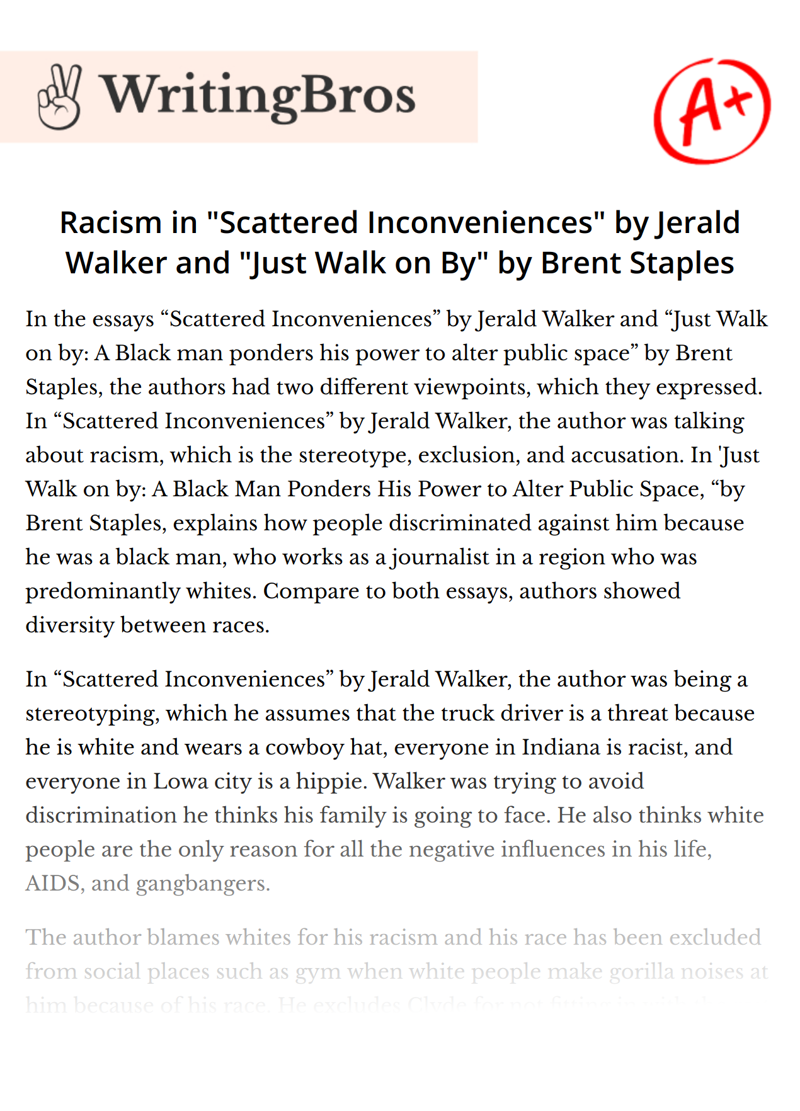Racism in "Scattered Inconveniences" by Jerald Walker and "Just Walk on By" by Brent Staples

In the essays “Scattered Inconveniences” by Jerald Walker and “Just Walk on by: A Black man ponders his power to alter public space” by Brent Staples, the authors had two different viewpoints, which they expressed. In “Scattered Inconveniences” by Jerald Walker, the author was talking about racism, which is the stereotype, exclusion, and accusation. In 'Just Walk on by: A Black Man Ponders His Power to Alter Public Space, “by Brent Staples, explains how people discriminated against him because he was a black man, who works as a journalist in a region who was predominantly whites. Compare to both essays, authors showed diversity between races.
In “Scattered Inconveniences” by Jerald Walker, the author was being a stereotyping, which he assumes that the truck driver is a threat because he is white and wears a cowboy hat, everyone in Indiana is racist, and everyone in Lowa city is a hippie. Walker was trying to avoid discrimination he thinks his family is going to face. He also thinks white people are the only reason for all the negative influences in his life, AIDS, and gangbangers.
The author blames whites for his racism and his race has been excluded from social places such as gym when white people make gorilla noises at him because of his race. He excludes Clyde for not fitting in with the rest of the people of color. “The Chevy switched lanes again, this time to the right. The driver was shouting at us through his opened window. I ignored him... The man tooted his horn and gave me a thumbs-up, then rode off into the night.” (Walker, 241). The author accused the Chevy driver was being racist and shouting at them for being colored people. But the reality was different, the Chevy driver was helping them by making horn sounds and shouting, because their back door was open, and the washer was about to fall. This essay showed that not all people are racists, there is a lot of good-hearted people.
In “Just Walk on by: A Black man ponders his power to alter public space” by Brent Staples, He realized about his frightened appearance to others, when he used to take late-night walks as a graduate student. Staples started his essays with an interesting story about a real incident, which fears based on his stereotypes. 'I only needed to turn a corner into a dicey situation, or crowd some frightened, armed person in a foyer somewhere, or make an errant move after being pulled over by a policeman.'(Staples, 218). It was a polysyndeton that values the impact that Staples was a different character by his presence. ' I could cross in front of a car stopped at a traffic light and elicit the thunk, thunk, thunk, thunk of the driver...hammering down the door locks'(Staples, 218-219). He uses the thunk to provide a description and qualities about his onomatopoeia. Staples wrote this essay with diverse incidents that prove his point of view and can change the tone of a public space almost instantaneously.
The racial factors in both essays were a diversity between racism. Walker thought that all the white people are racist, and he was trying to avoid discrimination he thinks his family is going to face. Staples was treated unfairly by whites because of his race. The fact between these essays, which not all people are racist, but there is a lot of people who treat unfair or discrimination to color people because of their race. The viewpoint of both essays was different: one story the author was being racist, but he got helped by the Chevy driver; another story the people were being racist to the author.
Compare to both essays, it shows people are trying to be racist because they think all people are racist. In Jerald Walker on telling a good story, the author was talking about the high metaphor he used in “Scattered Inconveniences”, the man in the Chevy represents the sin of American racism. Racism is now often these days; reckless life has left it frail and feeble. The author wanted to tell a good story, but the viewpoint of the reader's outcome might be different than the writer. Staples’s essays to Walker’s advice on how to tell a good story was considerate the incident with both authors, were people treated them differently because of their skin color. Some people are still not aware of such issues, admitting they are not racists, while their actions and words prove another point of this deal. There are lots of people who find their race better than another, making the relationships unequal in all aspects, this is what both authors were trying to show people in their essays.
Cite this Essay
To export a reference to this article please select a referencing style below

